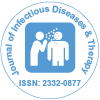Vitamin D Nutritional Status and Infectious Diseases
Received: 19-Jan-2018 / Accepted Date: 30-Jan-2018 / Published Date: 05-Feb-2018 DOI: 10.4172/2332-0877.1000349
Keywords: Hypovitaminosis; Vitamin D; Nutrition
Commentary
Hypovitaminosis D is highly prevalent worldwide [1]. Vitamin D importance is well known in bone diseases, but its role in infectious diseases has been recognised recently [2]. The main source of vitamin D is endogenous production in the skin under the influence of sun light. In the liver all vitamin D is hydroxylated to 25 hydroxyvitamin D (25OHD), which is the major circulating form of vitamin D, so serum levels of 25OHD are considered the best marker of nutritional vitamin D status. Under the control of feedback mechanisms 25OHD is hydroxylated in the kidney to the circulating hormone 1,25 (OH)2 D (calcitriol). Circulating calcitriol regulates calcium metabolism (“classical endocrine pathway of vitamin D”).
However, other cells can also synthetize calcitriol from circulating 25OHD after the activation of Toll like receptors by pathogenassociated molecular patterns of infectious agents (“non-classical intracrine/paracrine pathway”), independently of the calcium regulatory hormones [2,3]. Calcitriol activates its nuclear receptor (VDR) and so boosts innate immunity inducing increased secretion of antimicrobial peptides, such as cathelicidin (also known as LL-37) and B-defensin 2 in barrier cells (skin, respiratory tract, etc) and macrophages. Vitamin D-dependent antimicrobials belong to a group of evolutionary primitive, multifunctional cationic peptides that potentiate autophagy, destroy bacteria, fungus and virus and can induce other actions such as quimiotaxis, etc. [3]. Minimal serum levels of 25OHD for normal bone metabolism are 20 ng/ml [1]. These cut-off values are, however, controversial [1].
Although it has been demonstrated a high prevalence of hypovitaminosis D in infectious (mostly respiratory) diseases [4-8], it is difficult to establish if these changes are a cause or a consequence of the disease. Many respiratory infections are more prevalent in winter, when 25OHD levels are lower. On the other hand, 25OHD levels could be lowered by infectious diseases due to hyperconsumption of this metabolite.
Vitamin D supplementation used preventively or therapeutically for these conditions has been studied in many clinical trials and metaanalyses, with contradictory results [9], probably due to suboptimal quality of the studies, heterogeneous population, small number of patients, different doses and route of administration of vitamin D, and different clinical outcomes. Two recent meta-analyses of well-done clinical trials [9,10] conclude that vitamin D supplementation is safe and decreases the number of acute respiratory tract infections. Most benefit was found in patients with very severe vitamin D deficiency and in those not receiving bolus doses.
Infectious diseases are the cause of exacerbation of most chronic respiratory conditions. A meta-analysis of recent studies of supplementation with vitamin D has shown a decrease in number or symptoms of COPD exacerbations, especially in patients with severe vitamin D deficiency [9]. Curiously vitamin D supplementation has also shown to ameliorate asthmatic exacerbations, probably due to its immunomodulatory functions [11]. Up-to-now vitamin D supplementation as an add-on therapy for tuberculosis or pneumonia has not shown utility [9].
In conclusion, Vitamin D has an important role both in innate and adaptive inmunity. Hipovitaminosis D should be considered both in accute infectious diseases and in chronic diseases that predispose to infectious diseases.
References
Citation: Amado CA, Pérez MRI (2018) Vitamin D Nutritional Status and Infectious Diseases. J Infect Dis Ther 6: 349. DOI:
Copyright: © 2018 Amado CA, et al. This is an open-access article distributed under the terms of the Creative Commons Attribution License, which permits unrestricted use, distribution, and reproduction in any medium, provided the original author and source are credited.
Share This Article
Recommended Journals
Open 91桃色 Journals
Article Tools
Article Usage
- Total views: 4010
- [From(publication date): 0-2018 - May 05, 2025]
- Breakdown by view type
- HTML page views: 3185
- PDF downloads: 825
